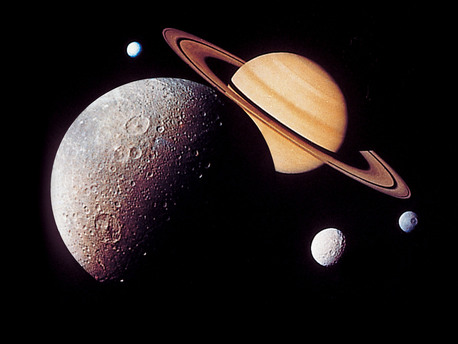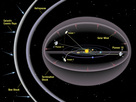Zero-gravity experiments
Space Research
 © NASA
|
This montage of images of the Saturnian system was prepared from images taken by the US Voyager 1 spacecraft during its Saturn encounter in November 1980. This artist's arrangement shows Dione in the foreground, Saturn rising behind, Tethys and Mimas fading in the distance to the right and Enceladus to the left
On German and international space missions, DLR has demonstrated its competence and capabilities, often in cooperation with international partners such as ESA (the European Space Agency) and NASA (America's National Aeronautics and Space Administration). Numerous research projects have led to pioneering results — often with highly beneficial applications back on Earth in medicine, agriculture, mechanical engineering and land surveying, to name just a few.
Telescience and robotics
In addition to expanding scientific know-how, DLR develops key operational technologies ranging from automated space flight control using robotics to future techniques such as telescience — controlling science experiments onboard spacecraft via remote radio commands.
Environmental monitoring from orbit
Mankind's development of space flight has given rise to Earth observation as a new discipline focused on our planet's atmosphere and environment. With the aid of satellite data, scientists can analyze many aspects of the environment that cannot be studied using traditional ground-based methods. Solving global problems requires a global perspective; the hole in the ozone layer, the 'greenhouse effect', pollution in the oceans and many other environmental problems can only be investigated thoroughly from space. Space-based environmental monitoring is crucial for developing comprehensive solutions.
Source: DLR - German Aerospace Center
Zero-gravity experiments
Space Research
 © NASA
|
This montage of images of the Saturnian system was prepared from images taken by the US Voyager 1 spacecraft during its Saturn encounter in November 1980. This artist's arrangement shows Dione in the foreground, Saturn rising behind, Tethys and Mimas fading in the distance to the right and Enceladus to the left
On German and international space missions, DLR has demonstrated its competence and capabilities, often in cooperation with international partners such as ESA (the European Space Agency) and NASA (America's National Aeronautics and Space Administration). Numerous research projects have led to pioneering results — often with highly beneficial applications back on Earth in medicine, agriculture, mechanical engineering and land surveying, to name just a few.
Telescience and robotics
In addition to expanding scientific know-how, DLR develops key operational technologies ranging from automated space flight control using robotics to future techniques such as telescience — controlling science experiments onboard spacecraft via remote radio commands.
Environmental monitoring from orbit
Mankind's development of space flight has given rise to Earth observation as a new discipline focused on our planet's atmosphere and environment. With the aid of satellite data, scientists can analyze many aspects of the environment that cannot be studied using traditional ground-based methods. Solving global problems requires a global perspective; the hole in the ozone layer, the 'greenhouse effect', pollution in the oceans and many other environmental problems can only be investigated thoroughly from space. Space-based environmental monitoring is crucial for developing comprehensive solutions.
Source: DLR - German Aerospace Center







